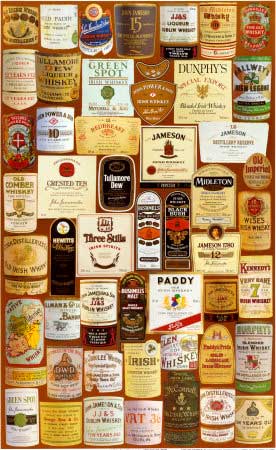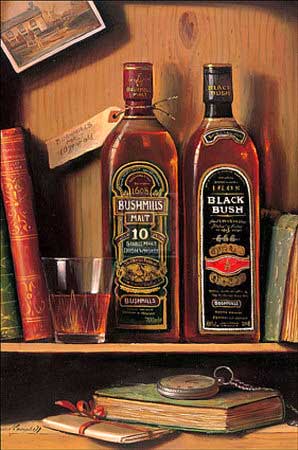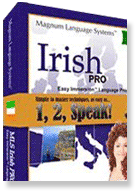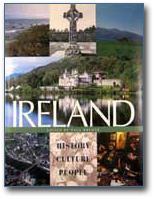The History of Irish Whiskey
 |
The history of Irish Whiskey, 'Uisce Beatha', meaning 'water of life' in Gaelic, began over 800 years ago. In the 16th century, Queen Elizabeth I was apparently quite fond of it but missed the opportunity to raise extra revenue by taxing the distillers. However, the opportunity was not lost forever because, on Christmas day in 1661, the government introduced a tax of four pence on each and every gallon of distilled whiskey.
By 1785 the tax on whiskey climbed to one shilling and tupence and, by 1815, it had risen to six shillings which proved to be too expensive for many. The result of this high tax drove many to produce their whiskey illegally and, by the end of the 18th century, there were some 2000 illicit stills in operation in Ireland. Many of these produced 'poteen' which is the equivalent to American 'moonshine' or 'white lightning'. Some of these distillers decided to become legal and tried to raise money to set up larger distilleries. Of those, the most successful, by far, were the three big Dublin distillers - John Power, John Jameson, and George Roe.
John Power & Son Whiskey:
James Power was originally a coaching innkeeper on Thomas Street in Dublin. It is probably unlikely that he could have known how successful his 'new' business would become when, in 1791, he founded a small distillery by converting his inn into a distillery. By 1800, James was joined in the business by his son John. Originally known as James Power & Son, by 1809 the business name was changed to John Power and Son, with James remaining in charge. The business continued to grow successfully and, in 1823, John Power boasted of a 500 gallon still with an annual output of 33,000 gallons of whiskey per year. This was the start of something big and, within another ten years, the company's yearly output had increased to over 300,000 gallons.
This success had benefits for a family that within one generation had risen from innkeepers to members of Dublin's high society. John Power was knighted and became High Sheriff of Dublin. Because of his celebrity he was chosen to lay the foundation stone for the O'Connell Monument.
In 1871, the distillery was rebuilt in classic Victorian style occupying almost seven acres. It was one of Dublin's most impressive sights and it employed approximately 300 people. John Power and Son continued in their success and became one of the largest Irish Whiskey distillers. Powers was the first Whiskey company to sell their product in miniature bottles called 'Baby Powers'. The importance of their influence in government facilitated changes to the distilling law in order to produce this innovation.The last member of the Board with the Power name was Sir Thomas Talbot Power. After his death in 1936, ownership remained in the family through his sisters. Powers remained a leading player in the industry until 1966 when they merged with the only two remaining distillers in the Irish republic, Cork Distillers Company and their long time rival, John Jameson & Son.
George Roe Whiskey:
George Roe and Company began in 1757 when Peter Roe bought a small distillery on Thomas Street in Dublin. This Thomas Street distillery was powered by the largest windmill at that time in all of Europe. Today, the windmill's tower still stands against the Dublin skyline. It is blue capped with copper sheeting and a weather vane in the likeness of St. Patrick. It is known as St. Patrick's Tower, and it is located on what is now Guinness property. In fact, two years after Peter Roe established the Thomas Street Distillery, Arthur Guinness set up his famous St. James' Gate Brewery across the street. Despite the fact that they were close neighbors, and that they shared the complementary businesses of producing alcoholic beverages, they did not share professional admiration for one another. Over the years, generations of the Guinness family considered their stout to be the 'nurse of the people', while they considered whiskey to be the 'curse of the people'. In private, it is suspected that generations of the two families would have enjoyed both Guinness Stout and Roe Whiskey.
In 1766, Richard Roe took over the Thomas Street Distillery and, in 1784, Nicholas Roe founded a separate distillery on Pimlico Street, a few blocks away. In 1832, his son, George Roe took over both the Thomas Street and Pimlico distilleries, consolidating and expanding them into quite a large complex. The resulting organization became known as George Roe & Company or Geo. Roe & Co., Distillers. George Roe's sons, Henry and George Jr., took over the company in 1862 and, by 1887, it had been built into the largest distillery in Europe. At that time the Thomas Street Distillery covered seventeen acres and Geo. Roe & Co., Distillers were producing two million gallons of whiskey annually. Roe whiskey had a large and important export to the United States, Canada, and Australia.
During the heyday of Geo. Roe & Co., Henry Roe donated a substantial portion of the Roe distillery wealth to the restoration of Christ Church Cathedral in Dublin. The restoration included the building of the attached Synod Hall, which now houses the tourist attraction, Dublina. Between 1871 and 1878, he donated the astronomical sum of 220,000 to 250,000 pounds, which is equivalent in today's market to approximately $25,000,000. Following its restoration, a new thoroughfare was cut in the vicinity of Christ Church and, although it was named Lord Edmund Street, a local witticism at the time was 'Roe Row'.
In 1889, Geo. Roe & Co., Distillers joined William Jameson & Co. and the Dublin Whiskey Distillery (better known as D.W.D.) to form a trading unit called the Dublin Distilling Company, Ltd. Each distillery continued to market its own whiskey under its own name and mark.
The late 19th and early 20th centuries was a very difficult period for the whiskey industry in Ireland, and the Roe distillery was no exception. Competition from Scottish blended whiskies, prohibition in the United States, and social and economic instability in Ireland caused many distilleries to fail. By 1926, Geo. Roe & Co., Distillers and its two partners, had ceased producing whiskey, although they still possessed large quantities of unsold stock in storage. In the mid 1940's, the Limited Company dissolved, and Geo. Roe & Co., Distillers went out of business. Finally, in 1949, Guinness took over the site of the old Roe Thomas Street Distillery.
During the early decades of the Thomas Street Distillery in Dublin, another line of the same Roe family established a distillery in New Ross, Co. Wexford - the Roe and Fletcher Distillery. Over the years, the Roes became the sole proprietors and their operation came to include a brewery as well. In 1832, the Roes sold the complex to an established brewing family, the Cherrys. Today Cherrys' Breweries Ltd. is part of The Waterford Brewery, and under the Guinness Ireland Group.
Jameson Whiskey:
John Jameson's Dublin Distillery was founded in 1780 and laid down a tradition for quality and success. His family motto and guiding philosophy was 'Sine Metu', meaning 'Without Fear', which appears today on every bottle of Jameson Irish Whiskey.
 |
Jameson set new standards in whiskey distilling by investing in the latest manufacturing processes. When he discovered that certain strains of barley made a superior whiskey, he persuaded local farmers to grow them by providing seed grain every spring. He also insisted that only the finest casks available were used for maturation.
By 1820, John Jameson & Son was the second largest distilling company in Ireland. News about the high quality of the Jameson whiskies traveled far and wide, and demand was growing abroad as well as in Ireland. The combination of fine whiskey ingredients and superior distilling processes was making quite a name for Jameson Whiskey worldwide.
In 1858, a blight destroyed France's vineyards and consequently supplies of brandy dried up. Traditional brandy drinkers switched to Irish whiskey and Jameson sales soared. By 1890, Ireland had about 90% of the global whiskey export market, and Jameson's distillery was making 10% of Ireland's annual whiskey output. After more than 100 years of growth and success, Jameson Whiskey was about to be dealt two cruel blows.
Before prohibition in 1919, Jameson was a best selling whiskey in America. After prohibition, exports of Jameson to the USA ground to a halt. Up until 1922, Jameson was the most popular whiskey in the British Empire but, after Irish Independence, tariff barriers priced it out of the market. Without overseas demand, all 400 Irish whiskey brands fell into decline.
By 1966, only three whiskey distilling companies were left in the Republic of Ireland and John Jameson & Sons was one of them. In a bold bid to keep the spirit of Irish whiskey alive, the four joined forces and formed Irish Distillers Group. In 1975, Irish Distillers opened a new state of the art whiskey distillery in Midleton. Co. Cork. Jameson Whiskey was then distilled outside of Dublin for the first time in 200 years.
Today, over 220 years after John Jameson opened his doors, Jameson Irish Whiskey is the fastest growing international whiskey in the world. To this day, John Jameson's passion lives on in the exceptionally smooth Irish whiskey that still bears his name.
Bushmills Whiskey:
Bushmills claim to be the 'Worlds Oldest Whiskey Distillery' is based on the undisputed fact that a seven year license to distill, dating from April 20th 1608, is attributed to the distillery. Located near the town of Bushmills, Co. Antrim, Northern Ireland, the distillery has had its ups and downs, which includes being destroyed by fire in 1885.
 |
Bushmills produces many fine whiskeys but the most well known is Bushmills Irish Whiskey. However, they also produce the classic Bushmills Black Bush. In 1996, they also started to supply Bushmills 16 year-old rare single Irish Malt Whiskey. It is now currently part of the Irish Distillers Group, having been bought in 1972.
Together, Power, Roe and Jameson formed the Irish Distillers Group. In 1989, the Pernod Ricard empire successfully bid against Gilbey's and Guinness-Cantrell-Cochran to become the new owners of the Irish Distillers Group, which also includes Bushmills Distillery. Due to Pernod Ricards' success, the last four members of the old distilling families resigned.
Disclaimer: LittleShamrocks.com is an affiliate website that receives commissions from sales of the products listed. We have purchased and sampled many, but not all, of the products on these pages.
© Copyright LittleShamrocks.com. All Rights Reserved.








